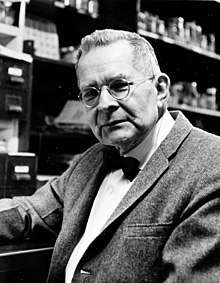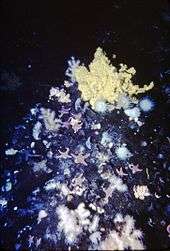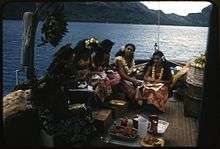Waldo L. Schmitt
Waldo LaSalle Schmitt (June 25, 1887 – August 5, 1977) was an American biologist born in Washington, D.C. He received his Ph.D. from George Washington University in 1922. In 1948, he received an honorary Doctor of Science degree from the University of Southern California. Schmitt's primary field of zoological investigation was carcinology, with special emphasis on the decapod crustaceans (crabs, lobsters, shrimp, and so on). His bibliography consists of more than seventy titles.[2]
Waldo L. Schmitt | |
|---|---|
 Schmitt in 1965 | |
| Born | June 25, 1887 |
| Died | August 5, 1977 (aged 90) |
| Alma mater | George Washington University |
| Spouse(s) | Alvina Stumm |
| Scientific career | |
| Fields | carcinology |
| Institutions | United States National Museum, Bureau of Plant Industry |
Background
- He was married to Alvina Stumm.[2]
- Schmitt was an Aide in Economic Botany for the United States Department of Agriculture (1907–1910)
- Appointed Scientific Aide in the Division of Marine Invertebrates of the United States National Museum
- Studied Crustacea with Mary Jane Rathbun
- Served on the staff of the United States Bureau of Fisheries as Scientific Assistant
- Naturalist aboard the Albatross (1911–1914)
- Assistant Curator at the United States National Museum as in the Division of Marine Invertebrates (1915–1920)
- Instructor of Zoology at George Washington University (1917)
- Named Curator of the Division of Marine Invertebrates (1920–1943)
- Head Curator of the Department of Biology (1943)
- Head Curator of Zoology (1943–1957)
- Honorary Research Associate and continued his association with the Smithsonian Institution until his death on 5 August 1977.
Biological expeditions

Invertebrates at 85 feet, Turtle Rock, Antarctica. Photo from Schmitt's Antarctic expedition, 1962-63
- 1918 studying the life history of the spiny lobster at the Scripps Institution of Oceanography, La Jolla, California.
- 1924–1925, was at the Carnegie Institution's Marine Laboratory at Dry Tortugas, Florida, surveying the crustacean fauna of the area, identifying crustaceans found in the stomachs of fishes.
- 1925, awarded the Smithsonian's Walter Rathbone Bacon Traveling Scholarship "for the study of the fauna of countries other than the United States." The scholarship enabled him to collect marine invertebrates along the east coast of South America.
- 1927 Schmitt was aboard Fleurus at Deception Island
- 1933–1935, to the Galápagos Islands sponsored by G. Allan Hancock of Los Angeles, California.
- 1937, a guest of Huntington Hartford, he explored and collected in the West Indies on the Smithsonian-Hartford West Indies Expedition.
- 1938, accompanied President Franklin D. Roosevelt as naturalist on the Presidential Cruise to Clipperton Island, Cocos, and the Galapagos Islands.
- 1939, member of the Hancock South America Expedition and
- 1940 Biologist in charge of field operations on the first United States Fish and Wildlife Service Alaska king crab investigation.
- 1941–1942, on special detail with the United States Navy investigating the possibility of establishing a biological station in the Galapagos Islands.
- 1943, visited South America, under the auspices of the State Department, for the purpose of strengthening relations between United States and Latin American scientists.
- 1955, headed the Smithsonian–Bredin Belgian Congo Expedition.
- 1956–1960 led Bredin-sponsored expeditions to the Caribbean (1956, 1958, 1959), the Society Islands (1957), and the Yucatan (1960).
- 1961–1962 Sponsored by a grant from the Office of Naval Research, Schmitt spent the summers of with Harry Pederson photographing the coral reef fauna of the Bahamas Islands.
- 1962–1963, his last expedition - member of the Survey of the United States Antarctic Research Program, the Staten Island cruise to Marguerite Bay and Weddell Sea.
Participation in Scientific Societies

Lobster lunch aboard the research vessel Mureva, with dancers from Bora Bora. Photo from Schmitt's Smithsonian-Bredin Expedition, 1956.
- Founding member of the Society of Systematic Zoology and served as president in 1948.
- President of the Washington Academy of Sciences in 1947.
- Trustee of the Bear's Bluff Laboratories,
- Trustee of the International Oceanographic Foundation
- Trustee of the Serological Museum of Rutgers University.
Legacy

Camp Schmitt
- Camp Waldo Schmitt, located in Augusta, West Virginia (39.353478°N 78.577712°W), is named in honor of Schmitt and his son, Waldo Earnest Schmitt.[2]
- Waldo's Wilds, a park in Takoma Park bears his name. [3] On this property was Schmitt's house. He donated it to the City of Takoma Park who did not have the money to maintain it so they gave it to the county. The house was demolished about 1990. The land had wonderful plants and shrubs he had collected from around the world as well as one of the largest trees in the county on it. 38.9699°N 77.0045°W[4]
- A seminar room in the National Museum of Natural History (Smithsonian Institution) bears his name.
- Schmitt Mesa in Antarctica.
- The clam genus Waldo is named after him.[5]
Further reading
- Richard E. Blackwelder (1979). The Zest for Life, or Waldo Had a Pretty Good Run: The Life of Waldo LaSalle Schmitt. Lawrence, Kansas: The Allen Press, Inc.
- John Sherwood (1977-01-11). "Uncle Waldo Still Hears the Call of Crustaceans". The Washington Star.
gollark: No mention of "original planet of humans"?
gollark: They assumed countries would act sanely.They were wrong.
gollark: I'm sure you can probably work out a better system if you don't go around confining it to either extreme.
gollark: Wiping out everything which ever has, will and could exist is much more efficient.
gollark: 0/10 - does not destroy entire totality of existence.
References
- Fenner A. Chace, Jr. (1978). "Waldo LaSalle Schmitt, 25 June 1887 – 5 August 1977". Crustaceana. 34 (1): 83–90. doi:10.1163/156854078x00583. JSTOR 20103251.
- David E. Lanar. "Review of the Life of Waldo LaSalle Schmitt, Father of Waldo Ernest Schmitt". bsa-troop33.net. Troop 33, Takoma Park. Retrieved 4 May 2010.
- "Takoma Park South Neighborhood Park". Montgomery Parks. Retrieved December 2, 2016.
- "Waldo's Wilds" (PDF). Takoma Voice. 2007-09-07. Archived from the original (PDF) on 2008-08-21. Retrieved September 2, 2016.
- Carrie Arnold (August 19, 2013). "Where's Waldo? Off the Pacific Coast". Weird & Wild, National Geographic. Retrieved September 15, 2013.
External links
| Wikimedia Commons has media related to Waldo LaSalle Schmitt. |
This article is issued from Wikipedia. The text is licensed under Creative Commons - Attribution - Sharealike. Additional terms may apply for the media files.